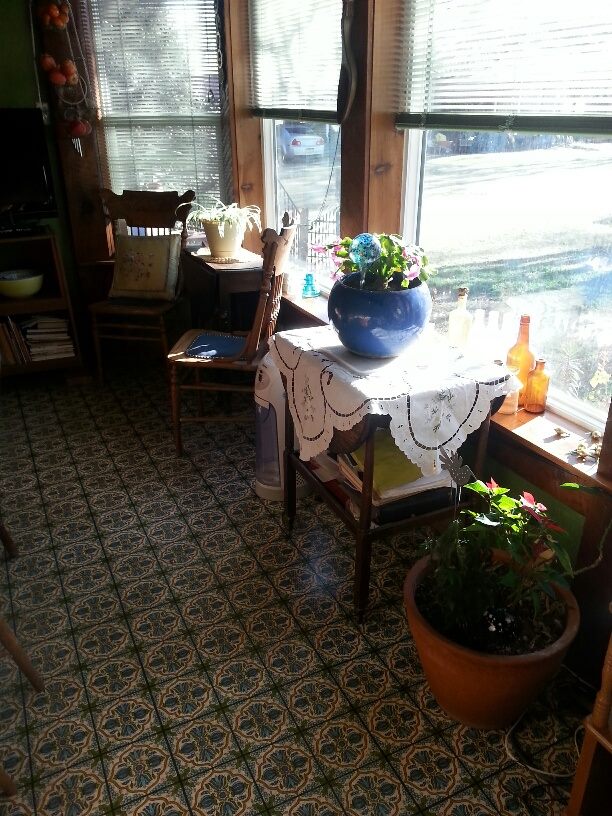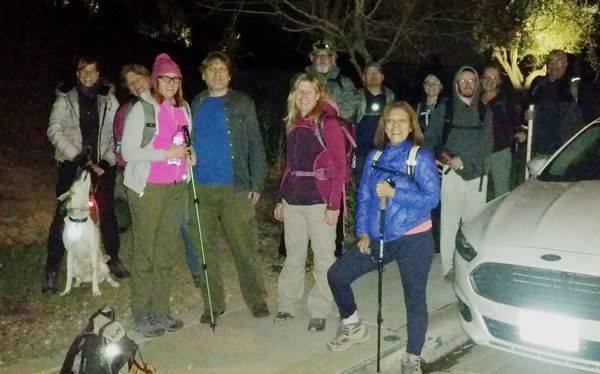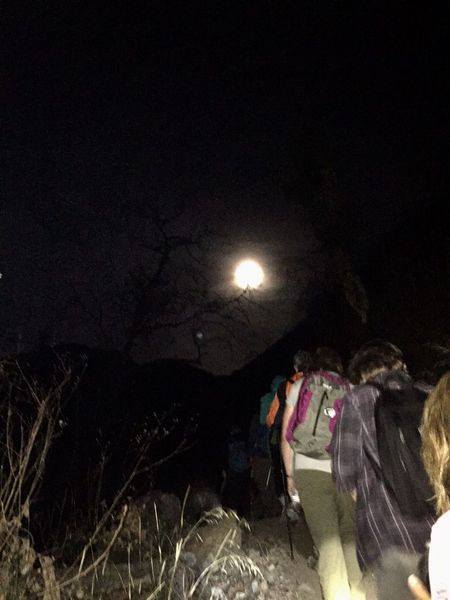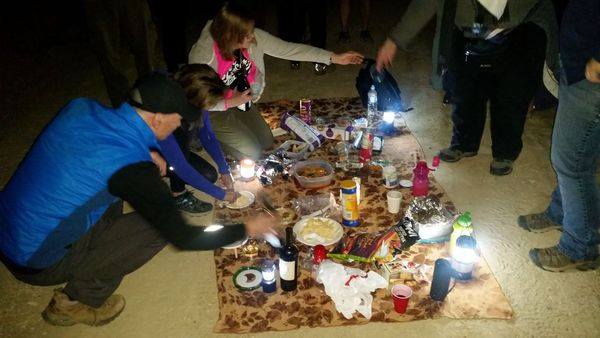Abandoned
I stared up at the cowboy illustration on the sign above The Plainsman restaurant. He resembled Charles Bronson: brooding, hat pulled down low on his forehead, large moustache. It looked like a cowboy had begrudgingly posed for the sketch artist – “Awwwwright, podna, make it snappy!” – and the result was the quick pen-and-ink drawing adorning the entrance to the restaurant. A giant wood carving of a rifle served as the signpost.
The diner, with its slanted shingle roof, looked like an inviting place to stop for a sandwich and a cup of coffee – the kind of place my parents would have taken us to eat during our road trip out west in 1970.
Except that it was completely deserted, and the doors were boarded up.
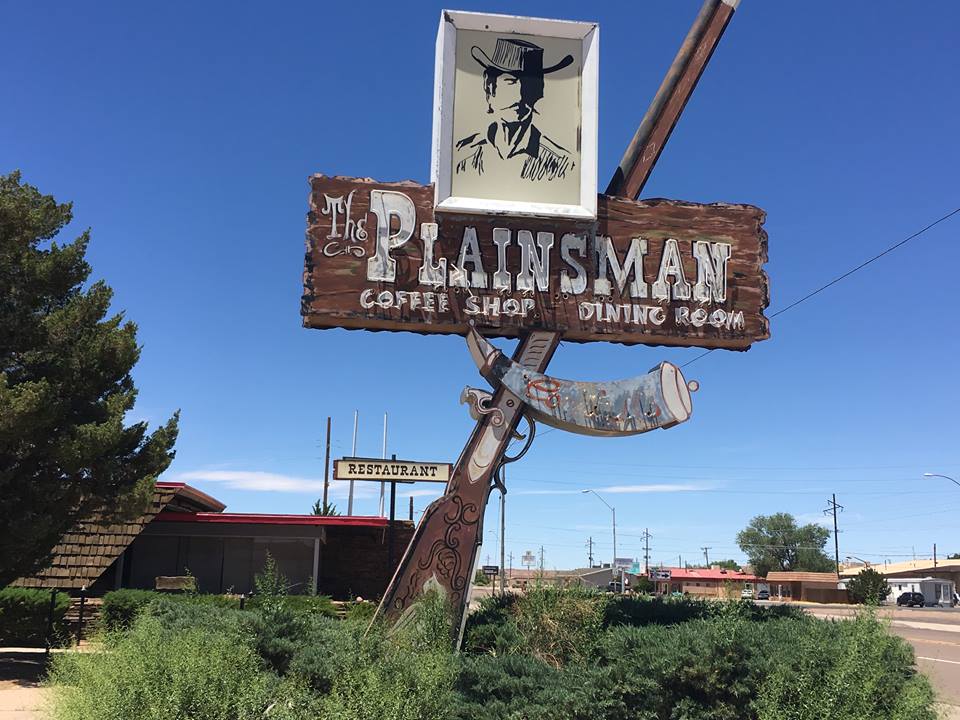
The Plainsman had galloped over the desert hills long ago, leaving his restaurant to slowly decay.
All throughout Route 66 we experienced this: diners, gas stations, hotels – once bustling with carefree vacationing tourists, now fading in the brutal desert sun.
The old road was like exploring an abandoned, post-apocalyptic hellscape, where precious family vacation memories were overtaken over by weeds, rot, and graffiti. The experience was exhilarating, magical, depressing, and bizarre – sometimes all at once.
The Broken Road
Anyone who’s traveled the Mother Road can tell you that it’s impossible to drive on it continuously. The road breaks up, veers off, stops dead; sometimes it is undrivable, sometimes it transitions into a private road, and sometimes abruptly ends with no warning.
Exiting on and off the far more reliable I-40 highway, which largely runs parallel to 66, we encountered giant lumberjacks, abandoned motels, deserted coffee shops, and random rabbits.

San Bernardino
Our Route 66 journey was the opposite of the classic trip which begins in Chicago and ends on the Santa Monica Pier – from the cold, dreary east to the golden west. Instead we were heading from west to east – from San Bernardino to Oklahoma City.
Since Dave and I had driven on the segments of old 66 that run through L.A., Santa Monica and Pasadena many times, we decided to begin our journey in San Bernardino – bleak, industrial, hot San Bernardino.
Driving by all the Denny’s and Jiffy Lubes and McDonald’s and concrete 1970’s apartment complexes, one can still catch glimpses of the past: old diners, abandoned drive-in theaters, gas stations, motels. Among the homogenous fast food restaurants are ghosts of a bygone era, of people seeking a new life, families on vacation, people running away from the old and predictable way of doing things into the unknown.
One of these ghosts is still very much active: the Wigwam Motel.
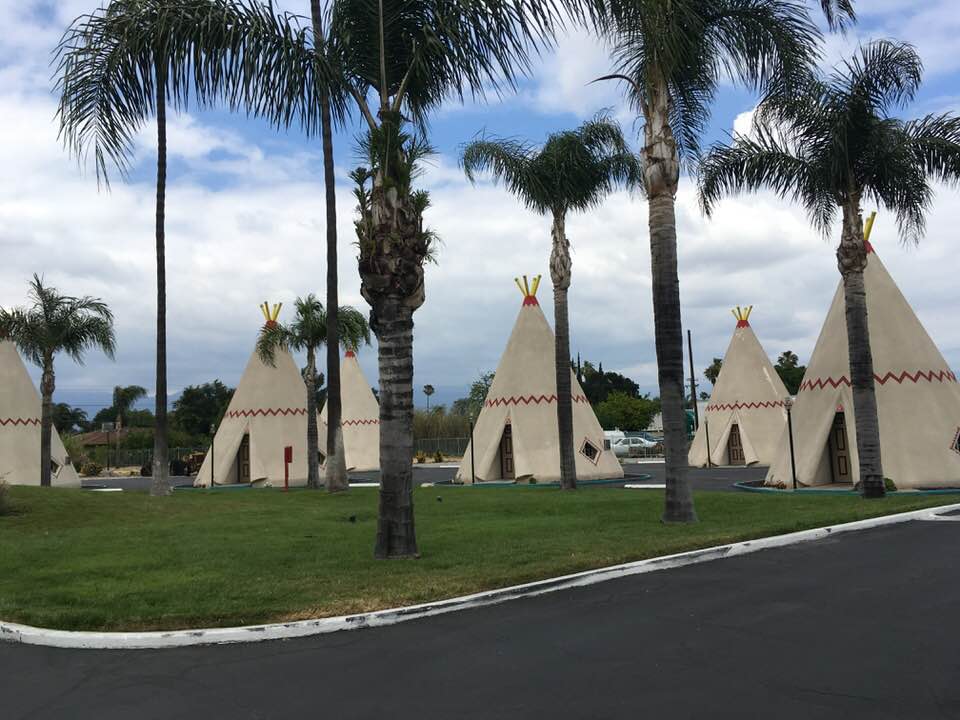
The Wigwam Motel
I’ve been fascinated with the Wigwam Motel ever since happening upon it during a short Route 66 drive in the 90’s
It was so kitschy and unreal, that I expected a cartoon version of a 1950’s tourist to come strolling out of one of the teepees, wearing a flowered shirt, camera around his neck.
In the 70’s, years after its tourist heyday, the Wigwam Motel was a sad, sleazy, rundown hangout. A sign reading “DO IT IN A TEEPEE!” hung in its main entrance.
Thankfully, in recent years the motel has been lovingly restored by its current owners, and each teepee has a bright coat of fresh paint. The lobby is full of Route 66 collectibles and items for sale in a glass case: signs, buttons, bumper stickers, postcards, etc.
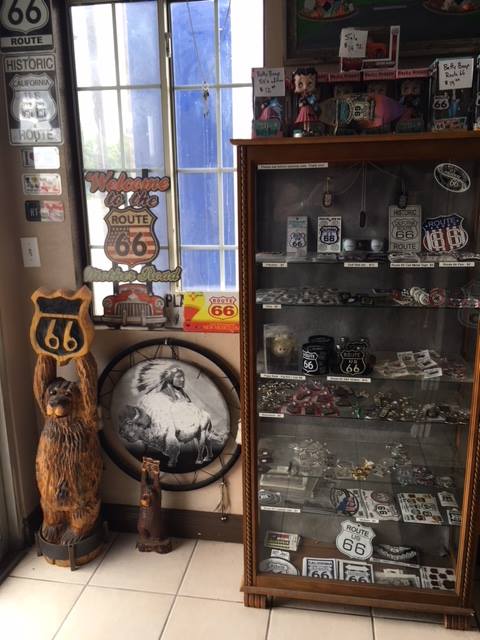
On the wall of the lobby are framed photos of the teepees’ interiors, from the 50’s. It was decorated in the cowboys-and-Indian style so popular at the time.
While I respect the new owners for renovating the exterior, I wish they’d renovated the interior to mimic the original. Instead, they’re decorated with flimsy velvet curtains and a sateen bedspread. The only thing in the room that seemed to evoke the mood and the time period was a kitschy cactus lamp. With all the wonderful retro-style fabric available now, it wouldn’t have been difficult to recreate the look.
That said, I am glad that they restored the outside of the teepees, as well as the grounds, to their former glory. Vintage cars from the 50’s and 60’s are parked in the lot, adding to the nostalgic mood. I could almost see Lucy, Ricky, Fred, and Ethel arriving to the motel, suitcases in the back, dressed in their vacation clothes, ready for adventure.
Bagdad Café
Originally called the Sidewinder Café, the Bagdad Café was renamed after being used in the cult film of the same name. It’s not located in the town of Bagdad, a remote ghost town about 55 miles east from the café on 66; rather it’s just off the Newberry Springs exit.

I haven’t seen the cult classic the café was named after, but after visiting the location in real life, I almost feel like I don’t have to. Other than the usual Route 66 t-shirts and bumper stickers for sale, nothing about the place appeared gimmicky or geared to tourists, and it was practically empty. A man with deeply-etched lines on his face, the kind of wrinkles you can only get from years living in the desert, sat behind the counter, staring vacantly into space. Two women, with the same hardened, weathered appearance, sat at a table in the corner.
In contrast to the glaring sunlight outside, it was extremely dark inside the windowless, wood-paneled cafe. The graffiti in the women’s restroom was written in many different languages. Travelers from all over the world had all flocked to this little café in the middle of the desert because of the film.
Amboy, CA
At Ludlow, the old road breaks away from I-40, and jogs through the desert for about 80 miles, joining up with the interstate again at Fenner. When the faster, smoother, and more convenient I-40 was completed in the area, travelers stopped driving through that stretch of 66, and businesses suffered as a result. The towns, with exotic names like Siberia and Bagdad, became deserted.
When we approached what remained of Amboy, I expected only deserted ruins, and was happily surprised to find a fully-functioning (vintage) gas station, coffee shop, and store.



I later found out that someone had bought Roy’s Café, the gas station, and the surrounding buildings. The location is mostly used for film shoots; a 1950’s style office reception area, decorated with Route 66 memorabilia, serves as its base.

While drinking my ice cold root beer, I spoke to a few guys who were seated outside, also enjoying cold sodas. They said they’d been living in downtown L.A.; weary of city life, they’d recently moved to Twenty-Nine Palms and were currently on a road trip adventure. I could relate.

Needles, CA
This sign, hanging outside the Wagon Wheel Restaurant, describes Needles perfectly:

Other than Wild West touristy fun of the restaurant (which features a collection of Levi’s jeans on its wall, from a tiny infant size to a pair fitting a 400-pound man), there’s not much to see in Needles. We passed one boarded-up house after another; what looked like a once-thriving section of town, was now practically deserted. Google Navigator directed us to drive through narrow, winding streets, past the abandoned houses, and through a graffitied tunnel. As if in a dream, we emerged from the gritty tunnel and were suddenly in a land of clear blue water, boats, and greenery.
We were in Arizona.
Williams, AZ
Known as The Gateway To The Grand Canyon, this charming town is filled with Route 66 artifacts, as well as the only gas station museum I’ve ever encountered.

A few semi-upscale restaurants, such as the South Rims Beer & Wine Garage, cater to both the Route 66 car nostalgia (the garage-themed brewery has a real vintage auto inside) as well as the culinary tastes of visitors from more urban areas (there are plenty of veggie and vegan options). But lest you think the town has lost its Wild West flavor, there are still plenty of diners
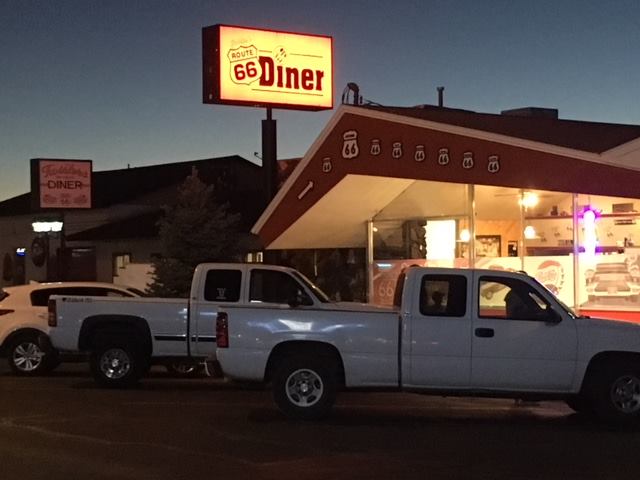
and steakhouses.
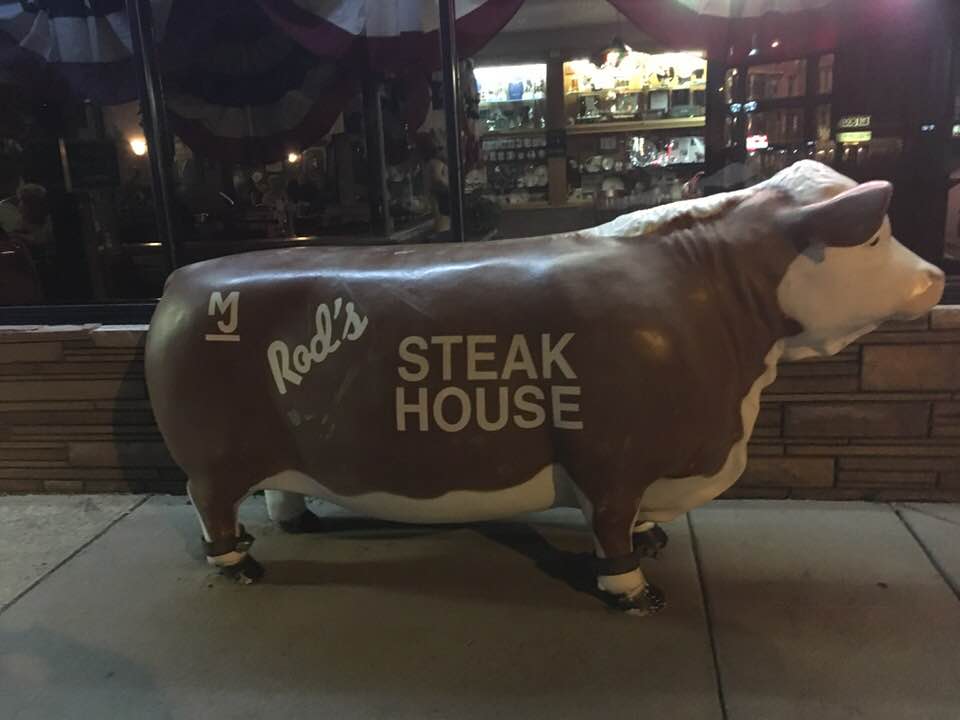
Winslow, AZ
“Standin’ on the corner . . . “ In downtown Winslow, in a very small park, there’s a plaque dedicated to this lyric from The Eagles’ hit “Take It Easy,” written by Jackson Browne, whose statue graces the corner.

Across the street from the tiny park is a store that sells Eagles and Route 66 memorabilia.
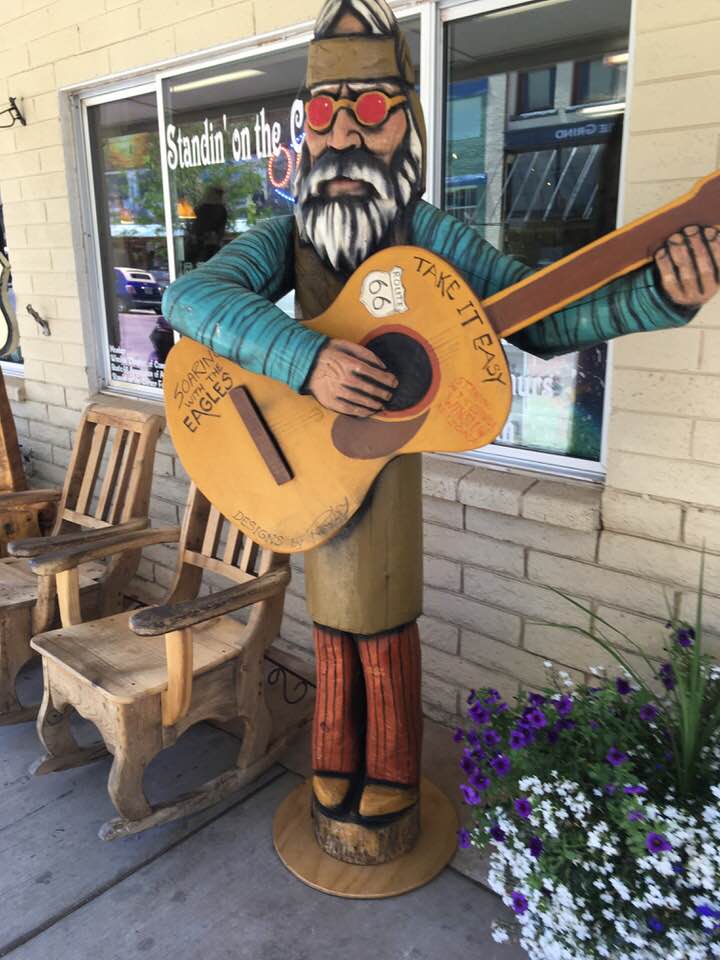

Other than that, there wasn’t much to see in downtown Winslow. Like much of Route 66, the town has seen better days.
Tucumcari, NM
More than anywhere else we visited on the old road, Tucumcari felt overwhelmingly creepy and post-apocalyptic – as if all human life had instantaneously disappeared, leaving everything as it was.
Despite the ghostly feeling of the town, some places, like the Blue Swallow Motel, are still in business.



Route 66 fanatics, with money to invest, have bought up some of the dying properties and restored them to their former glory. It was encouraging. I hope someday all of Route 66 will be restored.
Albuquerque
I loved Albuquerque, and the historic bed and breakfast where we stayed. It deserves its own blog post. Stay tuned.
The Texas Panhandle
It was hot. It was flat. It was Texas.
It also has this enormous cross, which appeared ominously on the horizon as we approached. Everything’s bigger in Texas.

Cadillac Ranch
The Texas panhandle was not my favorite part of our journey (hot/flat/endless), but I was excited to see the iconic Cadillac Ranch up close.

It’s not exactly part of Route 66 – it’s located on a frontage road just off I-40 – but it was close enough to be included on our journey.
Past attempts to discourage graffiti were in vain; it would seem now that the graffiti is now a permanent part of the exhibit.
(Of course, Bruce Springsteen’s “Cadillac Ranch” was going through my head the rest of the week.)
Oklahoma City, OK
Texas became less flat, barren, and dry, and more woodsy; we were approaching Oklahoma. As soon as we saw the “WELCOME TO OKLAHOMA” sign, I burst out singing the entirety of “Oklahoma” – “O-K-L-A-H-O-M-A!” – while my husband winced and shook his head.
We stayed in downtown Oklahoma City in Bricktown, a big change from the rural / desert feel of our journey so far. Our hotel was in walking distance of downtown bistros, breweries, and the river walk .

It was also a short walk to the Oklahoma City Dodgers’ stadium (the minor league team for the L.A. Dodgers), where we were attending a game the next night.
I highly recommend staying here. Not only is the downtown area full of things to do and great places to eat, you can book a luxurious apartment-sized hotel suite for about a fifth of the price you’d pay for in any other city.

When we arrived that night, it was 10:00. A ball game had just ended, and the streets were filled with baseball fans. We were hungry, and most restaurants were closed. (It might be a big city, but it’s still not a late-night destination like L.A. or New York.) The only place open that was serving any food was TapWerks Bar & Grill, down the street from our hotel on Sheridan Ave, housed in a turn-of-the-century brick building that looks like it was once a factory.
The waitress was friendly, and the food was much better than expected for bar food. I had a delicious veggie burger and a top-notch craft beer.
After visiting the city’s capital the next day, we strolled through the historic Knob Hill district and its turn-of-the-century mansions. That night, we walked through the humidity (in the 100 + degree weather, it was like walking inside a warm giant sponge) to the Oklahoma City Dodgers Stadium. It was surreal to see baseball fans outside of southern California wearing Dodger blue.
All I can remember about the game is that I was sweating profusely, and that the pre-show featured a waving cowboy standing in the back of a horse-drawn wagon. Also, I heard the song “Boot-Scootin’ Boogie” for the first time. We definitely weren’t in Southern California anymore.
Oklahoma loves its famous natives, and proudly displays their names everywhere on Bricktown street signs. Flaming Lips Alley intersects with Mickey Mantle Drive.

If you’re concerned that Oklahoma City’s Bricktown area has become too cosmopolitan, don’t worry. I’m pretty sure L.A. and New York don’t have their own American Banjo Museum (post photo). Sadly, we didn’t get a chance to visit. Next time, definitely.

Seligman, AZ
The last stop on our journey home was Seligman. Of all the places we visited, it was the one that most captured the spirit and essence of 66. It was the exact opposite of the mostly-desolate Tucumcari: it was alive and kicking.

Seligman is proud of its Route 66 roots. Like so many Route 66 towns, it began to fade away after I-40 was built, and travelers stopped using 66 as the main highway. Not wanting their town to disappear from the map, the residents convinced Arizona to designate Route 66 a historic highway. In 1987, Seligman was named The Birthplace of Route 66.
We stayed at a classic 66 roadside motel, The Supai. I noticed most of the other travelers were European; they seemed fascinated by this uniquely American experience.

The town is a combination of hippie, biker, artist, and desert dweller. I got the feeling that although they wear tie-dye and have long hair and beards, they’re probably also on largely on the conservative side.
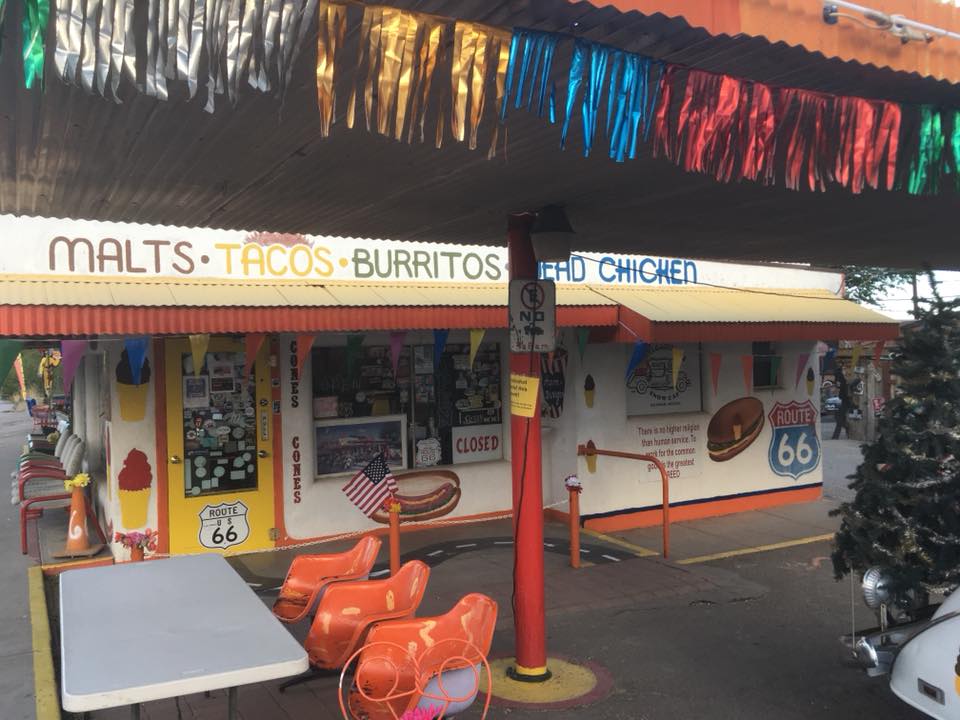

There aren’t a lot of food choices in a small town like Seligman, but Dave and I really liked the Roadrunner Café, which was walking distance from our hotel. We had ice cold beer and sandwiches for dinner, and in the morning, they served (good!) coffee and a tasty, healthy breakfast.


Though I was amused by the concept, we steered clear (no pun intended) of the Roadkill Café down the street, whose slogan is “You Kill It, We Grill It.” Their menu includes Deer Delectables, Bad-Break Steak, Fender Tenders, Splatter Papper, Swirl of Squirrel, and Big Bagged Stag.
Morning Rider on the Road
One of my favorite moments of the whole journey was walking down Route 66 just after sunrise to the Roadrunner Café for some coffee. It was still, quiet, and cool in the early morning hours. No one else was up and about yet, and the street was deserted. A train passed by on a nearby railroad.

I ordered some coffee and sat on the patio, looking out at the historic highway in the early morning light. It was the last day of our trip; later that afternoon, we’d be fighting traffic through the miserable urban sprawl of San Bernardino, and it would take hours before we were back at home in Ventura County. But for now, in that moment, I was alone with the historic Mother Road.

THE END



